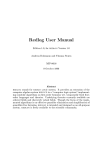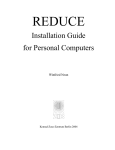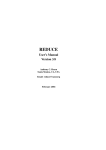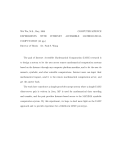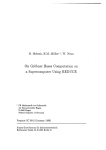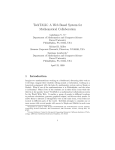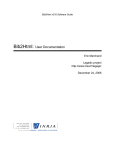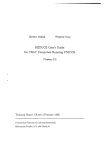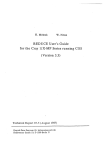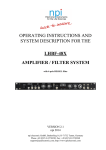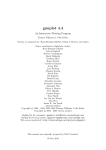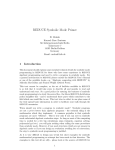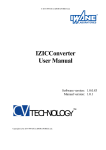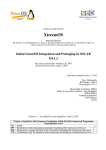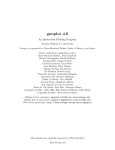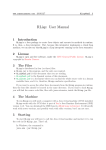Download reduce
Transcript
REDUCE User’s Guide for Unix Systems Winfried Neun Konrad-Zuse-Zentrum Berlin 2004 . REDUCE User’s Guide for the Unix Systems Version 3.8 by Winfried Neun ZIB D-14195 Berlin-Dahlem Federal Republic of Germany email: [email protected] September 2004 Abstract This document describes operating procedures for running REDUCE specific to the UNIX workstations. Copyright c 2004 Konrad-Zuse-Zentrum Berlin. All rights reserved. Registered system holders may reproduce all or any part of this publication for internal purposes, provided that the source of the material is clearly acknowledged, and the copyright notice is retained. Contents 1 What is new? 1 2 Preliminary 1 3 Introduction 1 4 Using "redfront" 2 5 REDUCE Documentation 2 6 Resource Requirement 3 7 File Handling 3 8 Internal Parameters 3 8.1 Object Sizes . . . . . . . . . . . . . . . . . . . . . . . . . . . . . . . . . . . . . . . . . . . . . . 3 8.2 Special Characters and Interrupts . . . . . . . . . . . . . . . . . . . . . . . . . . . . . . . . . . . 4 8.3 Miscellaneous . . . . . . . . . . . . . . . . . . . . . . . . . . . . . . . . . . . . . . . . . . . . . 5 9 Customizing the REDUCE Environment 6 9.1 Image Model of Executable . . . . . . . . . . . . . . . . . . . . . . . . . . . . . . . . . . . . . . 6 9.2 Size of Working Space . . . . . . . . . . . . . . . . . . . . . . . . . . . . . . . . . . . . . . . . 6 9.3 Initial Commands . . . . . . . . . . . . . . . . . . . . . . . . . . . . . . . . . . . . . . . . . . . 7 10 Communicating with UNIX 7 11 Recent information about REDUCE 8 12 XR: A X Interface for REDUCE 8 13 REDUCE Interactive Help system 8 14 GNUPLOT Interface for REDUCE 9 15 IZIC Interface for REDUCE 10 16 Implementation Dependent Error Messages 10 17 Further Help 11 1 What is new? Here is a summary for the experienced REDUCE user about the new features in the system dependent or technical parts of this version. There is a new REDUCE Web Site at http://www.reduce-algebra.com maintained by Anthony C. Hearn. Here the actual documentation can be found as well as the current patches file. There are also links to special packages and the the distribution sites. This version uses internal knowledge about the packages and their dependencies. The simple call to util/remake should keep the system uptodate and integrate patches, etc. There is a new directory wutil which contains system dependent binary programs. In most of the UNIX versions there is a subdirectory redfront which contains the (new) REDUCE frontend from by Thomas Sturm and Andreas Dolzmann from the University of Passau. This interface will be invoked automatically by the REDUCE start script. there is an interface to the Texmacs system by Joris v.d. Hooven et. al. by Andrej Grozin (U. Novosibirsk) and recently updated by Anrdeas Seidl (U. Passau) (see www.texmacs.org) 2 Preliminary This document describes operating procedures for running REDUCE specific to the UNIX workstations. It supplements the REDUCE User’s Manual, describing features, extensions and limitations specific to this implementation of REDUCE. This manual assumes that csh is used as the command shell. If a different shell is used, please change commands or filenames accordingly. 3 Introduction The files that form the REDUCE system are stored under the REDUCE root directory, identified here as “$reduce”. To execute REDUCE first check that the REDUCE binary directory, identified here as reduce.bindir is included in your search path. If not, the path definition in your .login or .cshrc file should be modified accordingly, e.g.: set path=( <reduce.bindir> $path) Alternatively, for calling REDUCE without a search path reference, you can put an entry in the .login or .cshrc file to define an alias for calling REDUCE directly, e.g.: alias reduce <reduce.bindir>/reduce Very often the reduce.bindir will be equal to the reduce root directory, but /usr/local/bin is also quite common. In order to access the REDUCE directories most easily, you should also include the statement (csh dependent) setenv reduce <REDUCE root directory> 1 Directories of interest to the general user include $reduce/doc, containing relevant documents and $reduce/packages, containing various examples of the use of REDUCE. The more serious user may also be interested in the REDUCE sources stored in the directory $reduce/packages also. To run REDUCE, you enter (in lower case only) reduce or, if you like a simple protocol of your session written into a file, reduce | tee -i <file> after which REDUCE will respond with a banner line and then prompt for the first line of input: REDUCE 3.8, 15-Apr-2004 ... 1: Please note that the date given above may vary, because from time to time a nnew patches file is integrated into the distribution. You can now begin entering commands. Alternatively you can enter the full pathname: <reduce.bindir>/reduce 4 Using "redfront" As an alternative to using the traditional tty–mode REDUCE version by typing reduce at the command prompt there is for most UNIX version aa little interface called redfront which starts an interface program which again starts REDUCE as a subprocess. The interface program uses the GNU readline library such that the functionality of this library is available. This interface is a new release of the older version of redfront. Among other things, it installs easier and it supports color output. 5 REDUCE Documentation REDUCE documents are kept in the directory $reduce/doc and its subdirectories, in the directory docextra, on the distribution CD–ROM and in the individual packages directories. These include descriptions of all user contributed packages and the following: reduce.tex REDUCE User’s Manual in LATEX format install.tex Installation instructions in LATEX format oper.tex primer.tex sl.tex System specific operation notes in LATEX format A Symbolic Mode Primer in LATEX format Standard LISP Report in LATEX format. If the directory $reduce/doc contains a document with both suffixes .tex and .doc, the LATEX version 2 is normally preferable. The .doc version is used by the help system only. The directory docextra contains ready-to-print versions for most of the manuals, in ps or pdf form. The REDUCE manual can be found there, too. The documentation for user contributed packages is included in the directory $reduce/packages/<package-name> together with the sources of the packages. 6 Resource Requirement The distributed version of REDUCE requires (depending on the machine architecture) at least 15 megabytes for storage of the executable binary file(s). At run time, it takes its default execution size from the underlying PSL system. This size can be changed at runtime with the set_heap_size command (see chapter 9.2). On 32 bit systems, this implementation will try to allocate up to 128 megabytes dynamically, if the operating system supplies a sufficiently large swap space on disks. This is not exactly true for MIPS systems (where one can raise the memory limit to 512 MB) and for Linux versions, where dynamic heap management is not implemented. In the later case, the system has to be started with a lot of heap available through the -td feature (see 9.2). On 64 bit systems, (if the 64 bit version of the software is used) there is virtually no limitation of address space. 64 bit versions are available for Compaq/Alpha, Mips R1x000 and Sparc/Ultrasparc processors. There are several limitations to the automatical allocation of swap space: Allocation fails. The message "Unable to allocate" followed by two numbers is indicating that reallocation of the heap fails for internal reasons. Please refer to the chapter "Customizing the REDUCE Environment". Lack of swap space. Please ask your system administrator. Some Unix operating systems have user specific limitations of the address space. Please check with a call of the limit command. If this is true, you may wish to increase the data segment size. Limitation of PSL address space. The PSL workspace is limited to 128 MB on 32 bit processors. 7 File Handling The file names that appear in in, out and shut statements follow normal UNIX conventions. If the name contains uppercase or special characters (e.g., $ ~ . /) it must be enclosed in double quotes (“FileName"). Whereas, if an identifier is used as a filename all characters are interpreted as lower case. Filenames containing patterns ~user, ~/ or $var are expanded , whereas patterns including * , ? , {...} or [...] are not expanded. 8 Internal Parameters 8.1 Object Sizes The maximum string and identifier lengths are limited only by the underlying PSL base. The current implementation allows several thousand characters in both identifiers and strings. However, we rec- 3 ommend that such names be limited to 24 characters or less for compatibility with other versions of REDUCE. In the default precision, floating point numbers are printed in fixed-point notation rounded to 12 digits. 8.2 Special Characters and Interrupts In its default mode REDUCE 3.8 is not case sensitive. The control of the character handling is now implemented by the operators input_case and output_case. Both operators accept arguments lower, raise or NIL. The former value of the case is returned, such that it can be restored easily. input_case controls the handling of characters on input. The default is lower, i.e. characters are mapped to lower case on input unless this is inhibited by using an exclamation mark. The command input_case NIL; will turn the system into a case sensitive mode. All REDUCE operators so far are stored in lowercase mode. Examples: 1: { aa, Bb, CC, !Dd , if AA = aa then "not case_sensitive" else "case_sensitive"}; {aa,bb,cc,Dd,not case_sensitive} 2: input_case NIL; lower 3: { aa, Bb, CC, !Dd , if AA = aa then "not case_sensitive" else "case_sensitive"}; {aa,Bb,CC,Dd,case_sensitive} 4: num(3/4); % Standard operators are now available in lowercase % only and lead to errors otherwise. 3 5: NUM(3/4); Declare NUM operator ? (Y or N) output_case controls the handling of characters on output. The default is NIL, i.e. no change will be done. Setting the output_case to lower or raise will raise or lower all characters printed outside of a string. For example: 1: input_case NIL; lower 4 2: { aa, Bb, CC, !Dd , if AA = aa then "not case_sensitive" else "case_sensitive"}; {aa,Bb,CC,Dd,case_sensitive} 4: output_case raise; % Value is nil and won’t be printed. 5: { aa, Bb, CC, !Dd , if AA = aa then "not case_sensitive" else "case_sensitive"}; {AA,BB,CC,DD,case_sensitive} The full 8 bit ASCII character set is supported with the exception of the character 0x80 (decimal 128). The end-of-file character is control D. A terminal interrupt (often del or control C) causes the current calculation to halt. The user is then prompted whether to continue the evaluation. If not, REDUCE prompts for the next command. In some cases the continuation prompt may be omitted and REDUCE immediately prompts for the next command. In order to get information about the current setting of the INTR key you can use the command system "stty -a"; from your REDUCE process. In general, the REDUCE processor is designed to allow the user to enter the interrupt character as often as required. The underlying LISP system tries to complete all ongoing operations which are not interruptable. escape is used to terminate strings in the REDUCE interactive editor. The usage of the interactive editor is not recommended. 8.3 Miscellaneous There are Gnu Emacs packages available for REDUCE from Francis J. Wright, Queen Mary College, London through his Homepage at: http://www.maths.qmw.ac.uk/ fjw/ The internal ordering on alphabetic characters is from A through Z followed by a through z. Times (as reported by on time; or showtime;) are given in milliseconds, and measure execution time and garbage collection time separately. They do not include operating system overhead (e.g., swapping time). To exit REDUCE use bye; . Alternatively, if you want to continue the REDUCE session later use <control>Z. To restart, one says fg, or another valid UNIX command for this purpose. Use the UNIX kill command to remove the job. In order to get information about the current setting of the SUSP or any other character you can use the command system "stty -a"; from your REDUCE process. 5 9 Customizing the REDUCE Environment 9.1 Image Model of Executable The customization of REDUCE described it this chapter depends on the way of storing the REDUCE specific information on disk which is used for the specific Operating System. There are two models, namely Executable Model. This is the traditional PSL model. REDUCE is stored as a executable binary file (e.g. in a.out, ELF, COFF format). Image Model. This model is a new one. REDUCE is stored as a shell script and an “image" (normally called reduce.img in the directory $reduce/lisp/psl/$MACHINE/red). The image is a PSL defined data structure which contains all PSL specific information. This image can be read in by the file $reduce/lisp/psl/$MACHINE/psl/bpsl, e.g. by invoking the shell script $reduce/reduce. When you start REDUCE and the first message is: Loading image file ... your system is an image system. 9.2 Size of Working Space The following section does not apply for Linux systems on Intel processors, because these use a different model of garbage collection. For these systems the memory requirements have to be installed beforehand. Depending on the complexity of your application, the amount of storage used by REDUCE for storing and manipulating your data will vary considerably. You may get an idea of the storage requirements however by turning on the switch gc: on gc; You will then get messages like: *** Garbage collection starting *** GC 2: 15-Jun-2004 16:12:53 (~ 1836 ms cpu time, gc : 28 %) *** time 289 ms, 50167 occupied, 51876 recovered, 949833 free at various points in your calculation. From these statistics you can see the amount of storage used, the free memory, and the percentage of cpu time spent on memory management (garbage collection). If the percentage is high, more than 20% say, it is recommended that you increase memory size. This can be done by the command: set_heap_size nnnnnnn; where nnnnnnn is the size in machine words of the dynamic storage. The default will be (in most cases) 1000000 words. The present memory size is returned by: set_heap_size nil; If you get an error message from set_heap_size, there are two ways to get a bigger workspace if 6 needed: Executable Model. Please ask your system adminstrator to build a bigger executable by changing parameters in $reduce/util/mkreduce Image Model. Please look at $reduce/reduce. This is normally a five lines script, which calls the program $reduce/lisp/psl/$MACHINE/psl/bpsl with a “-td nnnnnn" parameter. Please copy the script and modify the parameter nnnnnn (the workspace size in Byte). You can use up to 120 MB here on 32 bit processor systems. Please be aware that the allocation of huge swap spaces will significantly slow down the overall performance of your system. 9.3 Initial Commands When REDUCE is initialized, a .reducerc file, if present, will be read from the user’s home directory. This file can contain any REDUCE commands needed for customizing the REDUCE environment. Typically these are load commands to load specific user modules or the inclusion of local user directories through the LOADDIRECTORIES facilities. Please note the complete change for REDUCE 3.5: (or higher) The commands in the file have to be written in RLISP syntax and they are evaluated in algebraic mode. The file must contain an end; statement at the end. 10 Communicating with UNIX There are two different ways for a REDUCE user to communicate with the UNIX operating system: It is possible to issue a UNIX command and return to REDUCE at its completion by means of the command system. Alternatively, some UNIX functions are built into the REDUCE executable directly such that the user can influence the present task and interpret the system’s return value. The argument to system is a string which is then passed as a UNIX command to the Bourne (sh) shell. For example, system "vi foo/bah"; will edit the file foo/bah using the "vi" editor, and system "lpr foo/bah"; will print the same file. If you want to change for example your current working directory the command: system "cd /tmp"; is not of much use, since the cd command is run in a UNIX child’s environment and not in the REDUCE task environment. In this case the command cd "/tmp"; will produce the desired effect. More internally available functions are provided, including pwd, getenv and setenv. The latter work as described in the UNIX “man" pages, i.e., they expect parameters as strings, e.g. 7 pwd(); returns "/tmp/" setenv ("hugo","otto"); returns NIL and then getenv "hugo"; returns "otto" 11 Recent information about REDUCE Recent information about REDUCE and new or updated REDUCE packages or patches files can be obtained via the World Wide Web. The URL is http://www.reduce-algebra.com For distribution of REDUCE news and for discussing REDUCE topics of general interest there is an electronic mail forum. Every user of REDUCE is invited to participate. To register for this forum, or for further information, please send email to [email protected]. 12 XR: A X Interface for REDUCE XR is a program which interacts with REDUCE to provide a keyboard-and-mouse operated graphical user interface under UNIX and the X windowing system. It requires the presence of X11 Release 4, 5 or 6 with the Athena widget set. XR is not an integral part of REDUCE . It is developed at ZIB independently from the REDUCE development at RAND Corporation. It runs on most Unix platforms and ZIB will try to maintain this software. A description of XR can be found in a separate manual by Chris Cannam. XR provides: high-resolution graphical display of formulae; command history recall and editing with bracket matching; file logging and management; printer support in PostScript and ASCII, and LATEX transcription; a vaguely hypertexty help facility; dynamically user-selectable fonts. 13 REDUCE Interactive Help system The interactive help system is part of the XR X Interface, please refer to the XR description for the usage of this feature. Pressing the help button in XR should give a natural approach to the REDUCE reference manual pages and to the documentation of the user contributed packages. If XR is not available for your system, you may use the GNU info tool for interactive help, e.g. info -f $reduce/help/redref.info In the doc directory there are files in Adobe(R)s Acrobat(R) format (.pdf) which are ready to view 8 with an appropriate viewer. These files contain the REDUCE manual and the documentation of the packages in a hypertext style. 14 GNUPLOT Interface for REDUCE The GNUPLOT system provides easy to use graphics output for curves or surfaces which are defined by formulas and/or data sets. GNUPLOT supports a great variety of output devices such as VGA screen, postscript, pic TEX, MS Windows. The REDUCE GNUPLOT package lets one use the GNUPLOT graphical output directly from inside REDUCE, either for the interactive display of curves/surfaces or for the production of pictures on paper. REDUCE supports GNUPLOT 3.2 (or higher). For most systems GNUPLOT binaries are delivered together with REDUCE . However, this is a basic set only. If you intend to use more facilities of the GNUPLOT system or if your REDUCE has not been equipped with GNUPLOT binaries you should pick up the full GNUPLOT file tree from a server, e.g. dartmouth.edu monu1.cc.monash.edu.au irisa.irisa.fr A description of the REDUCE to GNUPLOT interface can be found in a separate manual by Herbert Melenk. GNUPLOT is not a part of REDUCE . The REDUCE to GNUPLOT interface has proved to work on all Unix platforms so far and ZIB will try to maintain this software. A simple test of the interface (on an X11 Display) should work like this: A simple plot for sin(1/x) : plot(sin(1/x),x=(-1 .. 1),y=(-3 .. 3)); The GNUPLOT developers have agreed that GNUPLOT binaries are distributed together with REDUCE. As GNUPLOT is a package distributed without costs, the GNUPLOT support of REDUCE also is an add-on to the REDUCE kernel system without charge. We recommend to anybody to fetch the full GNUPLOT system by anonymous FTP from a file server. 9 15 IZIC Interface for REDUCE Izic is a stand alone 3D graphic tool developed by Robert Fournier, Norbert Kajler and Bernard Mourrain from INRIA, Sophia-Antipolis, France. Izic can be run as a tool for displaying graphs computed by REDUCE . Moreover, there are facilities built into Izic, which allow the interactive manipulation of the picture data. The IZIC Interface for REDUCE was developed by Kerry Gaskell and later by Walter Tietze (both from ZIB). Please refer to the documentation, which is included in $reduce/izic/doc. The IZIC Interface is not available on some UNIX systems for various reasons. It needs a color display or a grey scale display on a Unix system equipped with X11 Rel 4 or higher. The present version does not work on a monochrome display. 16 Implementation Dependent Error Messages A number of error messages from the underlying PSL system may be seen from time to time. There are a lot of messages which may be issued by PSL which are not allowed to appear on the REDUCE user level and are therefore not listed here. The messages which are relevant in the user mode are: error in loading package xxxxxx or package not found This indicates (if the name xxxxxxx is correct) that the environment variable reduce is not set properly. Please change your shell’s resource file (e.g. .cshrc). 10 Floating point exception. overflow has happend. Probably means a division by zero has been attempted or a floating-point Heap space exhausted. Your problem is too large in its present form for the available workspace; either change your problem formulation or refer to the chapter Size of Working Space or ask your site consultant to build a bigger system for you. Non-numeric argument in arithmetic. an invalid argument. This means that a Lisp arithmetic routine has been called with Segmentation violation or Memory fault. This indicates an illegal memory reference. It can arise from applying the Lisp function car to an atom in compiled code. Bus error. This indicates an illegal memory reference. It can arise from applying the Lisp function car to an atom in compiled code. Binding stack overflow, restarting... This can arise from the evaluation of very complicated expressions. You can increase the binding stack by the set_bndstk_size command. For example, to set this to 100000, use: set_bndstk_size 100000; sh: gnuplot not found Please check the directory $reduce/wutil/$MACHINE/gnuplot for the binary gnuplot and gnuplot_x11. Error in kernel mode: system aborted (HP-UX only) The system has found itself unable to recover from an interrupt. If it is easy to reproduce that problem, please complain. Missing external MYCFLUSH (IBM RS/6000 only). The system call which is needed to run REDUCE is not installed properly. Please ask your system administrator. A note how to install the system call is found in the REDUCE Installation Guide. 17 Further Help For further help with REDUCE, please contact: list your site consultant here 11
















